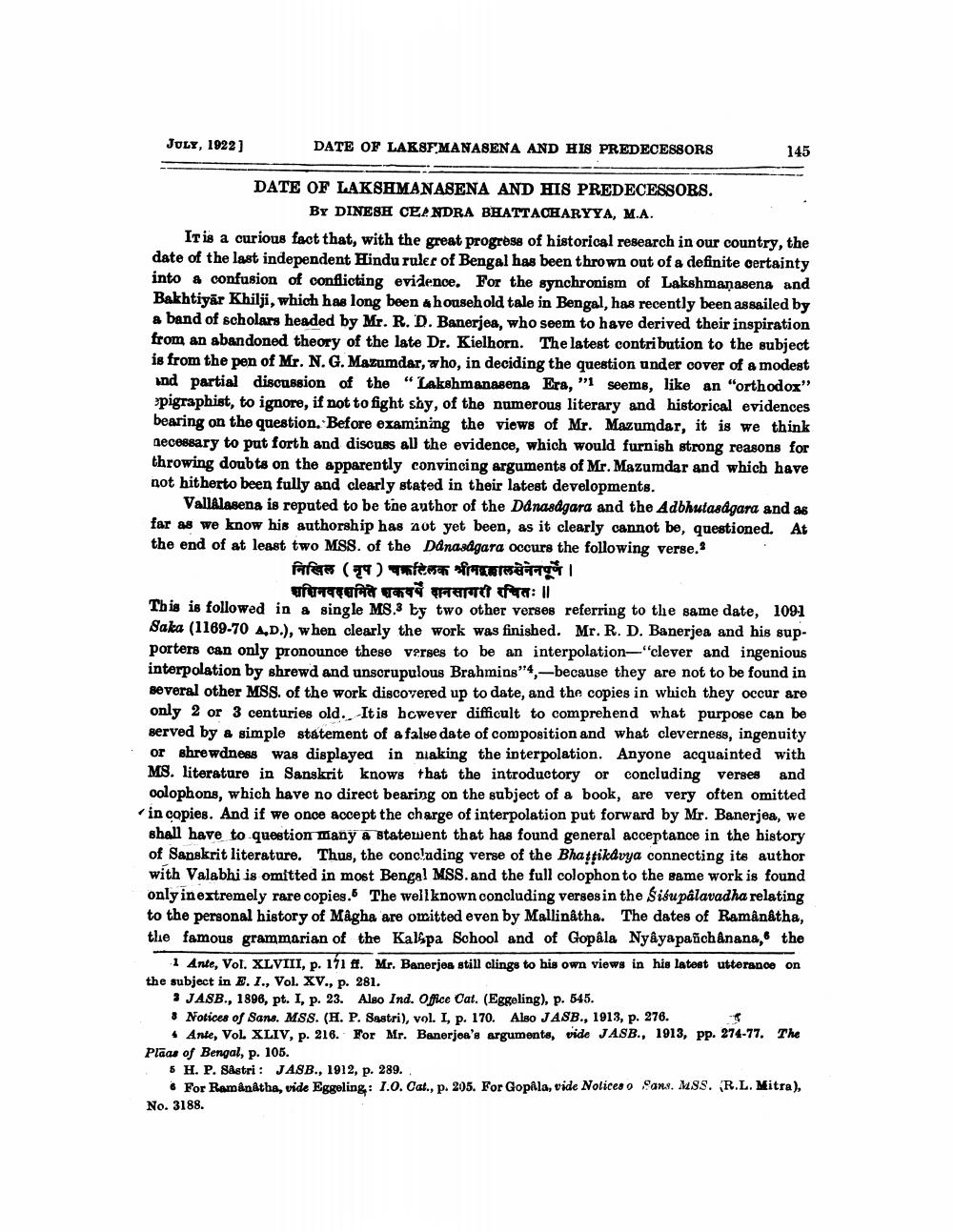________________
JULY, 1922]
DATE OF LAKSFMANASENA AND HIS PREDECESSORS
145
DATE OF LAKSHMANASENA AND HIS PREDECESSORS.
BY DINESH CENDRA BHATTACHARYYA, M.A. It is a curious fact that, with the great progress of historical research in our country, the date of the last independent Hindu ruler of Bengal has been thrown out of a definite certainty into a confusion of conflicting evidence. For the synchronism of Lakshmanasena and Bakhtiyar Khilji, which has long been & household tale in Bengal, has recently been assailed by a band of scholars headed by Mr. R. D. Banerjea, who seem to have derived their inspiration from an abandoned theory of the late Dr. Kielhorn. The latest contribution to the subject is from the pen of Mr. N. G. Mazumdar, who, in deciding the question under cover of a modest and partial discussion of the "Lakshmanasena Era," seems, like an orthodox" spigraphist, to ignore, if not to fight shy, of the numerous literary and historical evidences bearing on the question. Before examining the views of Mr. Mazumdar, it is we think necessary to put forth and discuss all the evidence, which would furnish strong reasons for throwing doubts on the apparently convincing arguments of Mr. Mazumdar and which have not hitherto been fully and clearly stated in their latest developments.
VallAlasena is reputed to be the author of the Danasdgara and the Adbhutasdgara and as far as we know his authorship has aot yet been, as it clearly cannot be, questioned. At the end of at least two MSS. of the Danasdgara occurs the following verse.
Parera (79) at fremmedagot
अधिनवदधामिते शकवर्षे दानसागरी रचितः॥ This is followed in a single MS.3 ky two other verses referring to the same date, 109-1 Saka (1169-70 A.D.), when clearly the work was finished. Mr. R. D. Banerjea and his supporters can only pronounce these verses to be an interpolation-"clever and ingenious interpolation by shrewd and unscrupulous Brahmins"4,-because they are not to be found in several other MSS. of the work discovered up to date, and the copies in which they occur are only 2 or 3 centuries old. It is however difficult to comprehend what purpose can be served by a simple statement of a false date of composition and what cleverness, ingenuity or shrewdness was displayed in niaking the interpolation. Anyone acquainted with MS. literature in Sanskrit knows that the introductory or concluding verses and colophons, which have no direct bearing on the subject of a book, are very often omitted in copies. And if we onoe accept the charge of interpolation put forward by Mr. Banerjea, we shall have to question many a statement that has found general acceptance in the history of Sanskrit literature. Thus, the concluding verse of the Bhattikavya connecting its author with Valabhi is omitted in most Bengal MSS. and the full colophon to the same work is found only in extremely rare copies. The well known concluding verses in the Sisupalavadha relating to the personal history of Magha are omitted even by Mallinåtha. The dates of Ramanatha, the famous grammarian of the KalSpa School and of Gopāla Nyâyapanchanana, the
i Ante, Vol. XLVIII, p. 151 ff. Mr. Banerjea still clings to his own views in his latest utterance on the subject in E. I., Vol. XV., p. 281.
? JASB., 1896, pt. I, p. 23. Also Ind. Office Cat. (Eggeling), p. 545. * Notices of Sans. MSS. (H. P. Sastri), vol. I, p. 170. Also JASB., 1913, p. 276.
4 Ante, Vol. XLIV, p. 216. For Mr. Banerjoa's arguments, vide JASB., 1913, pp. 274-77. The Plaas of Bengal, p. 105.
6 H. P. Sastri : JASB., 1912, p. 289.
& For Ramánátha, vide Eggeling: 1.0. Cat., p. 205. For Gopala, vide Notices o ane. MSS. (R.L. Mitra), No. 3188.




